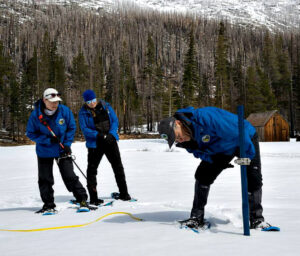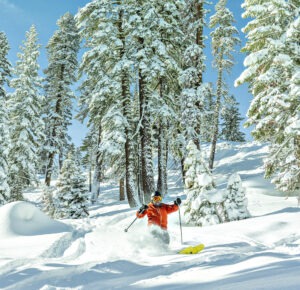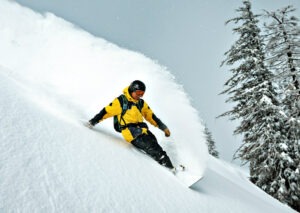Snowstorms were not abundant this ski season. However, enough winter storms hit the Lake Tahoe region to provide a nearly normal season for snowpack.

The Department of Water Resources (DWR) did its final snowpack survey of the season Friday (March 28) and announced that it was 90% of normal, a good sign for California’s water supply, according to state officials.
The Sierra snowpack has now had near-average levels for a third year in a row, said DWR manager Andy Reising, who handles snow surveys and water supply forecasting. Tahoe ski resorts have reported modest totals this season that included almost zero snowfall in January.
SEE TAHOE RESORT SEASON SNOW TOTALS BELOW
Reising measured the snow in the morning amid a steady stream of snowflakes at Phillips Station, located near Sierra-at-Tahoe ski resort off Highway 50. This annual measurement marks the traditional peak of the Sierra Nevada snowpack that feeds much of California’s water supply throughout the year.
The survey at Phillips Station recorded a snow depth of 39.5 inches and a snow-water content of 17 inches.
The Tahoe region is expected to see more snow dropping, starting early Sunday morning and periodically coming down into Tuesday (April 1).

“This will be the third year in a row that the snowpack conditions at the start of April are near or above the average,” Reising said. “And there’s more in the forecast. While it’s positive news today, we know that our luck could run out and we could fall into a drought any time.”
This year’s measurements is a sharp uptick from a year ago, when the statewide average lagged at 38%. But the weather is fickle from year to year. There was a record-smashing snowpack of 2023, which measured more than twice the historical average.
Snow levels at this time of year are considered especially important, since they help water managers determine how much water will be available through the dry season, which typically begins around May.
The March storms didn’t just improve snowpack, they also boosted reservoir levels statewide.
The state’s largest reservoir – Lake Oroville – is now at 87% of capacity and 121% of its historical average for this time of year. Earlier this week, DWR raised the State Water Project allocation forecast to 40% of requested supplies, up from 35% last month, citing improved conditions.
As of Friday, Folsom Lake sat at 128% of its historical average and 79% of capacity with anticipated runoff starting to ramp up. San Luis Reservoir is at 89% of capacity and 104% of its historical average. Only Castaic Reservoir in Southern California was lagging – 79% of capacity and 94% of its historical average.

TAHOE RESORT SEASON SNOW TOTALS (March 29)
- Sugar Bowl: 373
- Palisades Tahoe: 332
- Mt. Rose: 325
- Soda Springs: 311
- Boreal Mountain: 307
- Northstar 260
- Kirkwood: 259
- Sierra-at-Tahoe 209
- Heavenly 205
- Diamond Peak 198
- Tahoe Donner: NA
- Granlibakken: NA